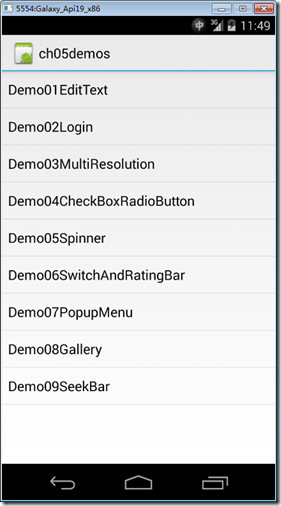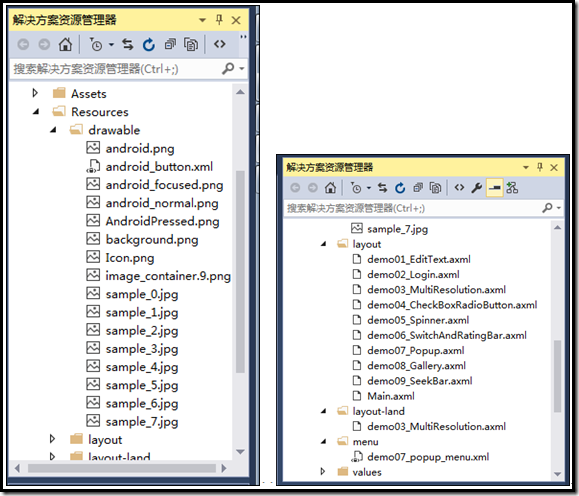分类:C#、Android、VS2015;
创建日期:2016-02-06
这一章主要介绍Android简单控件的基本用法。本章源程序共有9个示例,这些示例都在同一个项目中。
项目名:ch05demos,项目模板:Blank App(Android)
运行主界面截图如下:
点击每行的示例项,即进入对应示例的页面。
1、在drawable文件夹下添加图片
添加的图片见下面的左图,也可以直接拖放图片到drawable文件夹下。
右图是各节例子实现后的纵向屏幕布局文件(layout文件夹)、横向屏幕布局文件(layout-land文件夹)、弹出菜单布局文件(menu文件夹)。这些都是在本章后续将要介绍的节中添加的。
2、主界面(Main.axml)
修改后的代码如下:
<?xml version="1.0" encoding="utf-8"?> <LinearLayout xmlns:android="http://schemas.android.com/apk/res/android" android:orientation="vertical" android:layout_width="fill_parent" android:layout_height="fill_parent"> <ListView android:minWidth="25px" android:minHeight="25px" android:layout_width="match_parent" android:layout_height="match_parent" android:id="@+id/listView1" /> </LinearLayout>
3、主界面对应的活动文件(MainActivity.cs)
本章示例全部完成后MainActivity.cs的代码如下:
using System; using Android.App; using Android.Widget; using Android.OS; using ch05demos.SrcActivity; namespace ch05demos { [Activity(Label = "ch05demos", MainLauncher = true, Icon = "@drawable/icon")] public class MainActivity : Activity { string[] items; protected override void OnCreate(Bundle bundle) { base.OnCreate(bundle); SetContentView(Resource.Layout.Main); items = new string[] { "Demo01EditText", "Demo02Login", "Demo03MultiResolution", "Demo04CheckBoxRadioButton", "Demo05Spinner", "Demo06SwitchAndRatingBar", "Demo07PopupMenu", "Demo08Gallery", "Demo09SeekBar" }; ListView listView1 = FindViewById<ListView>(Resource.Id.listView1); listView1.Adapter = new ArrayAdapter<string>(this, Android.Resource.Layout.SimpleListItem1, items); listView1.ItemClick += (s, e) => { int index = e.Position + 1; switch(index) { case 1: StartActivity(typeof(Demo01EditText)); break; case 2: StartActivity(typeof(Demo02Login)); break; case 3: StartActivity(typeof(Demo03MultiResolution)); break; case 4: StartActivity(typeof(Demo04CheckBoxRadioButton)); break; case 5: StartActivity(typeof(Demo05Spinner)); break; case 6: StartActivity(typeof(Demo06SwitchAndRatingBar)); break; case 7: StartActivity(typeof(Demo07PopupMenu)); break; case 8: StartActivity(typeof(Demo08Gallery)); break; case 9: StartActivity(typeof(Demo09SeekBar)); break; } }; } } }
注意:直接定义字符串数组这种方式虽然用法最简单易理解,但并不是最好的办法,下一章再介绍比这个稍微好一点的办法(但仍然不是最好的办法,别着急,一步一步来,要不你没有比较怎么知道哪个好哪个坏呢)。
4、清单文件(AndroidManifest.xml)
在这个文件中只添加了一条内容:设置应用到所有页面的公用主题。
<?xml version="1.0" encoding="utf-8"?> <manifest xmlns:android="http://schemas.android.com/apk/res/android" package="ch05demos.ch05demos" android:versionCode="1" android:versionName="1.0"> <uses-sdk /> <application android:label="ch05demos" android:theme="@android:style/Theme.DeviceDefault.Light"> </application> </manifest>
从下一节开始,将分别介绍如何实现各个示例,以及这些示例涉及的相关概念。

